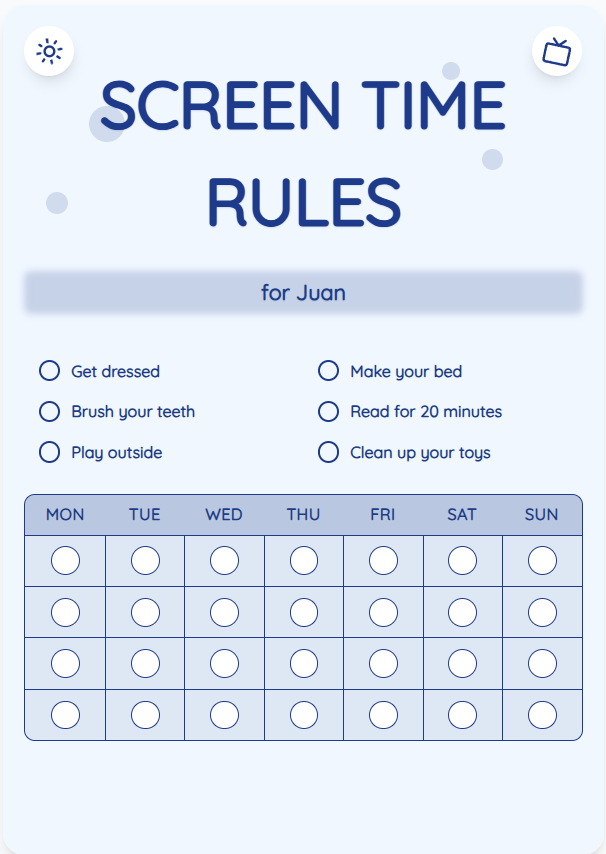How to Manage Screen Time Limits for Children: Practical Tips for Parents
As a parent, finding the right balance for your child's screen time can be challenging. In this guide, we'll explore effective strategies and practical tips to set and enforce screen time limits while promoting healthy child development and family bonding.
See What Your Screen Time Chart Will Look Like
Here's an example of a beautiful, customizable screen time rules chart you can create for your family

Understanding the Impact of Screen Time on Child Development
Excessive screen time can impact children's physical health, cognitive development, and social skills. It's crucial to be aware of these effects to make informed decisions about screen time limits for your child. Research suggests that children aged 2-12 should have limited screen time to ensure their overall well-being.
Setting Realistic Screen Time Limits
Establishing clear and consistent screen time rules is essential. Consider factors like age-appropriate content, duration, and quality of screen time activities. Utilizing screen time charts can help visually represent these limits for your child, making it easier for them to understand and follow.
Put These Tips Into Action
Create a custom chart to implement these strategies with your child
Promoting Alternative Activities
Encourage your child to engage in non-screen activities such as outdoor play, reading, arts and crafts, or family bonding time. By offering a variety of stimulating alternatives, you can reduce their dependency on screens and foster a well-rounded development.
Monitoring and Adjusting Screen Time Limits
Regularly monitor your child's screen time usage and be prepared to adjust limits as needed. Open communication about screen time rules and expectations is key to ensuring cooperation and understanding from your child. Remember, flexibility is important while maintaining consistency.
Practical Tips for Success
- Create a daily screen time schedule with specific time slots for different activities.
- Use positive reinforcement and rewards for adhering to screen time limits.
- Lead by example by practicing healthy screen time habits yourself.
- Involve children in setting their own screen time boundaries to promote responsibility.
Frequently Asked Questions
How can screen time charts help in managing screen time limits?
Screen time charts visually display allocated screen time slots, helping children understand and adhere to set limits. They provide a tangible reference for both parents and kids to track and manage screen time effectively.
What are the signs of excessive screen time in children?
Signs of excessive screen time include irritability, lack of interest in other activities, disrupted sleep patterns, and decreased social interactions. Monitoring these signs can help identify when screen time limits need adjustment.
How can I handle resistance from my child when enforcing screen time limits?
Address resistance with empathy and understanding. Encourage open dialogue about the reasons behind the screen time rules and the importance of balance. Consistency, positive reinforcement, and setting clear consequences can help overcome resistance over time.
By implementing these strategies and tips, you can effectively manage screen time limits for your child, promoting a healthy balance between screen activities and other enriching experiences. Consider using screen time charts from ScreenTimeRules.com as a valuable tool in creating a structured approach to screen time management.
Ready to Transform Your Family's Screen Time?
Join thousands of parents who have successfully managed screen time with our customizable charts.
